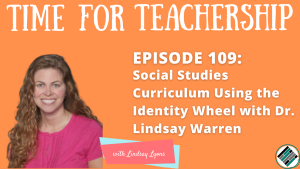 109. Social Studies Curriculum Using the Identity Wheel with Dr. Lindsay Warren Share on X
109. Social Studies Curriculum Using the Identity Wheel with Dr. Lindsay Warren Share on X
Dr. Warren’s philosophy of teaching is based on her educational experiences, starting with taking the AP test and realizing she didn’t know how to answer the questions about women. Her teacher said there wasn’t enough time. “[Teachers] have a lot of power to do good and also potential to do harm.”
The Big Dream
For all students to be seen. To get a more comprehensive history in front of students in an integrated, authentic way in which multiple identities and histories are woven throughout the entire course. “Not everyone is doing it in that authentic, holistic way. They’re doing it in a checkbox way. Maybe even our leadership is telling them to do it in a checkbox way.”
The dream is for us to sit with truth and sit with joy. We can learn about who the people are that are making change happen and how they’re doing that.
Alignment to the 4 Stages: Mindset, Pedagogy, Assessment, and Content
Dr. Warren and her colleagues developed a curriculum and presented it to students to see if it met their needs and wants. They created an identity wheel that considers access to structural power for each identity group, which has been a helpful tool for students to grapple with these ideas. The vast majority of teachers and students are able to use this well. It’s led to beautiful, nuanced conversations. It’s designed for teachers to be able to use it to their comfort level. For example, it may be used to explore the identities and access to power for an author of a text like Ida B. Wells.
The wheel works well to grapple with big essential questions like: Who is an American? Using primary sources to learn about U.S. History is a way to frame the conversation in truth and breaking down any myths students may have learned in younger grades.
A Thematic Approach
Teaching thematically has engaged Dr. Warren’s students through U.S. History I content, when the minutiae doesn’t feel very relevant to students. Each unit goes through the 100-year time period for the course (1820s-1920s) through different themes. Here are the themes Dr. Warren uses for U.S. I:
- Unit 1: Causes and Consequences of National Conflict
- Unit 2: Political and Economic Changes Unit
- Unit 3: Social Change and Reform
- Unit 4: Territorial Expansion (e.g., settler colonialism to colonialism)
- Sample question for students to grapple with: “What is this democracy really fighting for and how democratic are we?”
Unit Design Pieces
Start with Questions: Course-long Essential Questions, Unit-specific EQ, and Guiding Questions
Establish the historical context.
Lesson-Level (Skill-Building) Protocols Include:
- Document Analysis: Historical documents. Use the wheel to analyze identities/groups
- Discussion: Socratic Seminar and small group work via document analysis
- Inquiry-based research activities
Summative Assessment Example: Annotated Bibliography (common assessment) paired with a Student-Led Research Project
Mindset Shifts Required
Make it authentic to your style and your classroom.
Don’t allow your discomfort to get in the way of what your students need. We are adults. We will survive being sweaty.
Ask yourself: How can I make more of my students feel seen? What do they really need when they leave my classroom?
Ask your students: How do you learn best?
One Step to Get Started
Trust students with difficult things. Give students opportunities to reflect in writing and verbally.
Stay Connected
You can find Dr. Warren on LinkedIn.
To help you design curriculum and instruction that centers historically marginalized identities, Dr. Warren is sharing her Identity Wheel with you for free. And, if you’re looking for more details on the ideas in this blog post, listen to episode 109 of the Time for Teachership podcast. If you’re unable to listen or you prefer to read the full episode, you can find the transcript here.
Quotes:
- “I’ve literally seen the power of my queer kids hearing about queer soldiers in the Civil War, hearing about queer suffragettes…in the Progressive Era…I’ve seen…little… moments of…’Oh! This suddenly matters to me’”
- “We can’t allow our discomfort get in the way of what they need. I can be sweaty. It’s fine.”
- “Trusting [students] to handle difficult things…Trusting that you have enough control over the culture of that classroom and environment..that you can ensure they’re not going to be glib about it…Yes, ask kids, talk to kids, but also trust kids. And trust them to think about big issues, things that are going on.”
